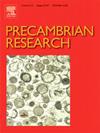The formation of a unified basement of the Yangtze Craton
IF 3.2
2区 地球科学
Q2 GEOSCIENCES, MULTIDISCIPLINARY
引用次数: 0
Abstract
The Yangtze Craton has a long evolution history since the Eoarchean. With the increasing number of studies on the Yangtze Craton, ten Archean-Paleoproterozoic basements, separated from each other, have been identified. These basements may represent independent microcontinental blocks before they were amalgamated into a unified basement. To decipher their affinities with each other and when these microcontinental blocks joined together to form the basement of the Yangtze Craton, we compiled the Archean-Mesoproterozoic magmatic and metamorphic events and zircon U-Pb ages with Hf isotope data of magmatic rocks in these basements. Magmatic activities of basements in the Yangtze Craton mainly occurred within nine periods: approximately 3.7 Ga, 3.1–2.9 Ga, 2.9–2.7 Ga, 2.7–2.6 Ga, 2.5–2.4 Ga, 2.4–2.2 Ga, 2.1–1.9 Ga, 1.9–1.7 Ga, 1.7–1.6 Ga. By comparing the timings of tectono-thermal events and calculating the likeness of igneous zircon Hf isotopes between them, we reconstructed the assembly history of these microcontinental blocks and the formation time of the unified basement of the Yangtze Craton. The amalgamation history can be briefly summarized as: Yangkou was assembled with Dabie at ca. 3.7 Ga; Cuoke was merged with Phan Si Pan during 3.1–2.9 Ga to form the proto-south Yangtze Craton; Zhongxiang and Kongling were assembled during 2.9–2.8 Ga; Yangkou-Dabie, Zhongxiang-Kongling, and Yudongzi were assembled during 2.7–2.6 Ga; Feidong and Douling joined the Yangkou-Dabie-Zhongxiang-Kongling-Yudongzi assemblage during 2.5–2.4 Ga, constituting the proto-north Yangtze Craton. The coeval development of ca. 2.0 Ga metamorphism in the proto-south and the proto-north Yangtze Craton suggests that the amalgamation of the Yangtze Craton may have occurred as early as approximately 2.0 Ga. The occurrence of 1.9–1.7 Ga A-type granites and mafic dykes indicative of extension in both the northern and southwestern blocks marks the final assembly of the Yangtze Craton. The development of late Paleoproterozoic-Mesoproterozoic sedimentary strata with sporadic interlayered mafic volcanics in most parts of the Yangtze Craton suggests the stability of the Yangtze Craton. Based on the aforementioned evidence, we propose that a unified basement of the Yangtze Craton was formed no later than the late Paleoproterozoic, coeval with the final assembly of the supercontinent Columbia (Nuna).
形成了统一的扬子克拉通基底
扬子克拉通自太古宙以来具有悠久的演化历史。随着对扬子克拉通研究的增多,已确定了10个相互分离的太古宙-古元古代基底。这些基底在合并成一个统一的基底之前可能代表着独立的微大陆块体。为了揭示这些微陆块之间的相互关系以及它们何时结合形成了扬子克拉通基底,我们利用这些基底岩浆岩的Hf同位素数据,编制了太古宙-中元古代的岩浆变质事件和锆石U-Pb年龄。扬子克拉通基底岩浆活动主要发生在约3.7 Ga、3.1 ~ 2.9 Ga、2.9 ~ 2.7 Ga、2.7 ~ 2.6 Ga、2.5 ~ 2.4 Ga、2.4 ~ 2.2 Ga、2.1 ~ 1.9 Ga、1.9 ~ 1.7 Ga、1.7 ~ 1.6 Ga 9个时期。通过构造-热事件时间的比较和火成岩锆石Hf同位素相似性的计算,重建了这些微陆块体的组合历史和扬子克拉通统一基底的形成时间。合并史可简单概括为:约3.7 Ga时,阳口与大别合并;3.1 ~ 2.9 Ga,库克与潘斯潘合并,形成原南扬子克拉通;钟祥和孔陵在2.9 ~ 2.8 Ga形成;洋口-大别、中乡-孔岭和鱼洞子形成于2.7 ~ 2.6 Ga;2.5 ~ 2.4 Ga时,肥东和灌岭加入了洋口-大别-中乡-孔岭-鱼洞子组合,构成了原北扬子克拉通。原南、原北扬子克拉通约2.0 Ga变质作用的同期发育表明,扬子克拉通的合并可能早在2.0 Ga左右就发生了。北部和西南地块均出现1.9 ~ 1.7 Ga a型花岗岩和具有伸展性的基性岩脉,标志着扬子克拉通的最终拼合。扬子克拉通大部分地区发育晚古元古代—中元古代沉积地层,并有零星的层间基性火山活动,说明了扬子克拉通的稳定性。根据上述证据,我们认为扬子克拉通统一基底的形成不迟于晚古元古代,与哥伦比亚(努纳)超大陆的最终拼合在同一时期。
本文章由计算机程序翻译,如有差异,请以英文原文为准。
求助全文
约1分钟内获得全文
求助全文
来源期刊

Precambrian Research
地学-地球科学综合
CiteScore
7.20
自引率
28.90%
发文量
325
审稿时长
12 months
期刊介绍:
Precambrian Research publishes studies on all aspects of the early stages of the composition, structure and evolution of the Earth and its planetary neighbours. With a focus on process-oriented and comparative studies, it covers, but is not restricted to, subjects such as:
(1) Chemical, biological, biochemical and cosmochemical evolution; the origin of life; the evolution of the oceans and atmosphere; the early fossil record; palaeobiology;
(2) Geochronology and isotope and elemental geochemistry;
(3) Precambrian mineral deposits;
(4) Geophysical aspects of the early Earth and Precambrian terrains;
(5) Nature, formation and evolution of the Precambrian lithosphere and mantle including magmatic, depositional, metamorphic and tectonic processes.
In addition, the editors particularly welcome integrated process-oriented studies that involve a combination of the above fields and comparative studies that demonstrate the effect of Precambrian evolution on Phanerozoic earth system processes.
Regional and localised studies of Precambrian phenomena are considered appropriate only when the detail and quality allow illustration of a wider process, or when significant gaps in basic knowledge of a particular area can be filled.
 求助内容:
求助内容: 应助结果提醒方式:
应助结果提醒方式:


